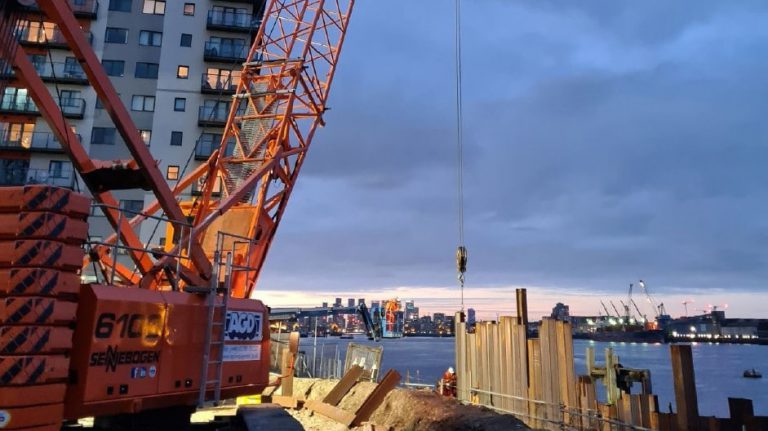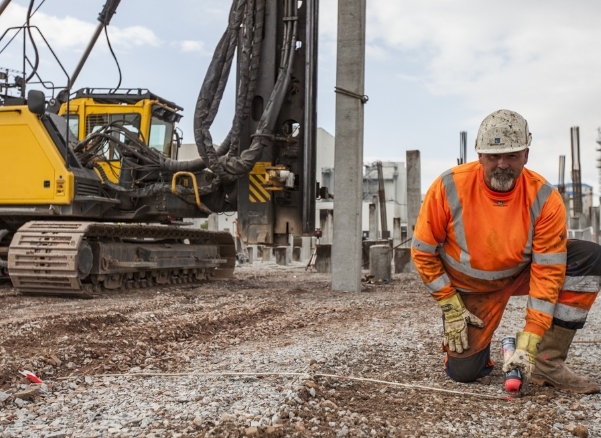Need a sheet piling solution? 10 things to understand before you enquire
Categories:
Company NewsAarsleff Ground Engineering is a leading UK sheet piling contractor with extensive experience and expertise in designing and installing specialist retaining wall solutions. With the experience of working on over 25 sheet piling projects per year, we’ve pulled together key information regarding sheet piling that will help you deeper understand the technique.
1. What is sheet piling used for?
Starting from the beginning, let’s look at what sheet piling is used for.
Sheet piling is used to provide both temporary and permanent walls. Sheet piling is used as excavation support and for soil retention. In simple terms, it creates a border that keeps the earth back, away from the structure.
Sheet pile walls are used to support excavations for various structures, including below-ground parking structures, basements, pump houses, and foundations, to construct cofferdams, and to construct seawalls and bulkheads.
Permanent steel sheet piles are designed to provide a long service life; however, when construction is taking place in a confined space, temporary walls may be used to prevent material ingress, offering protection to the workers working in the vicinity of the area.
In a home environment, sheet piling is used as permanent walls as they provide stability and durability to the interior walls (especially basement walls).
2. What are the different types of sheet piles?
- Wooden sheet piles
- Wakefield piles
- Steel sheet piles
- Precast concrete sheet piles
- Light-gauge aluminium sheet piles
- Vinyl sheet piles
- Fibreglass sheet piles
- Cantilever sheet piles
3. How do you install Sheet Piles?
To achieve the full performance of your structure, your sheet pile must be driven to the depth specified by the wall designer.
- Most scenarios will involve some preparatory work before you begin the construction of your sheet pile structure. Indeed, many sites will require excavation. To have more mobility in building, for burying anchors or ultimately changing the landscape, preparatory work will need to be done first.
- A temporary driving guide is highly recommended for building a straight wall. By assembling a driving guide before you begin the installation, you establish an accurate wall position and provide a surface to drive against that keeps the sheet piling plumb.
- Some forethought needs to be given to the sheet orientation before you begin. First, the most popular way to drive is with the male lock leading; the rationale being that the female lock tends to fill up with soil and hinder driving is used as the leading edge.
- Arrange the sheets in sections to check if the piles will interlock correctly or not.
- Hammer install the first sheet to the defined depth as per the design. You may want to mark your desired driving depth on your sheet to ensure sufficiently driven.
- Use vibratory hammers for installation but use impact hammers if the soil is hard or dense and the loss of penetration occurs.
- Use hydraulics to push the sheets into place if vibrations are prohibited at that particular site.
- After the first sheet is placed, drive the second sheet to interlocks with the first one.
- Corner pieces are available for any sheet pile that you might purchase. These pieces come in various configurations. Drive these just as you would a sheet pile. Alternatively, you can thread your corner piece on the leading lock of the last sheet to be driven and drive the sheet and the corner piece together.
- After you are satisfied that your corner is in position, drive your next box position, lining it up, using the corner’s male lock and your driving guide.
- After you are satisfied that this sheet is adequately positioned, secure the sheet to your guide.
- Repeat the process until the wall is completed.
- Use connector elements to maintain the integrity of the wall if it requires complex shapes.

4. How deep can sheet piles go?
Let’s look at a case study
Chesterfield Associates Inc. commenced a project in November 2017 to replace the steel sheet piling on a pier at the Port Jefferson Ferry Terminal in New York state.
The pier at Port Jefferson Ferry Terminal is about 300 feet long and 80 feet wide. The original structure, made of wood timbers, is about a hundred years old. It has been reframed at least a couple of times, most recently in the late 1980s.
A steel bulkhead ties into the landward end of the pier. Pile lengths required around the pier range from about 50 feet to 90 feet at the pier’s deepest point. The sheet piles installed in the 1980s had deteriorated in many places.
The new piles, at 0.625-inches thick, should have a longer service life of 50 to 60 years. This was the first job ever that Chesterfield Associates worked on that required two high mats. Moving the mats alone required six tractor-trailer loads.
The longest sheet piles required for the depths of the project weighed eight tons a pair. Specialised stretch trailers transported two pairs at a time to the site.
Chesterfield Associates team extracted the old sheet piling from around the pier. About 40 metres of old piling was extracted and replaced at a time; the template used to hold the structure in line during this process is 40 feet long. Generally, the cycle of excavation, old pile extraction and new pile installation for the 40 feet would take two to three days, depending on bottom conditions; obstructions could add significantly to that time.
Requiring more power to install the new piling, the company rented a Model 50B vibratory hammer to drive up to 90 feet in the soil conditions at the pier.
Sometimes when the old piling was being extracted, some of the previous structures moved into the path of the new piling. Divers were required to enter the water to deal with the obstructions.

Do you have a project that would benefit from sheet piling? Email your enquiry to info@aarsleff.co.uk and an expert will be in touch.
5. How wide are sheet piles?
The “standard” sheet pile was the 400 – 420mm wide U pile for several decades in the UK
Converting from a narrow, inefficient pile to a wide modern pile can save up to 27% on weight whilst offering equivalent driveability and strength.
In the 1980s, the 525mm wide range overtook the older sections, offering much higher strength per unit weight but with reduced capacity to withstand sub-optimal driving practice. The 600mm wide U pile was initially resisted because of fears over driveability, but the efficiency and need to compete with Z piles soon overcame these reservations. The 600mm wide U pile is still the standard temporary works You pile today.
Larssen PU12 – 600mm width
Arcelor Mittal AZ – 630mm width
ArcelorMittal AU – 750mm width
Today we see even wider piles with U piles up to 750mm wide and Z piles up to 800mm wide. These piles offer maximised economy (optimised strength to weight ratio) but have clever additions such as strengthened shoulders to ensure driveability is not compromised.
6. Are sheet piles watertight?
A sealing system provides a cost-effective solution to control water seepage through the wall, for instance, to minimise the risk of settlement of adjacent property or keep excavations dry.
The water tightness of ArcelorMittal or Larssen interlocks invariably improves with time, but a sealant provides a means by which the flow of water can be controlled faster and more reliably.
The water flow through sealed interlocks can be calculated with a practical design method backed up by several in-situ full-scale tests.
Each construction project is unique because of ground conditions, water tightness requirements, installation methods and vary from site to site. Therefore, the choice of a sealing system must be made carefully considering all the specific constraints and requirements.
The integrity of a sealant will depend upon its suitability regarding the installation and the driving method, as well as the soil and water conditions.

7. What is a cantilever sheet pile?
Cantilever sheet piles are walls that do not have any supports and thus have a free, unsupported excavation. Cantilever walls restrain retained earth by the passive resistance provided by the soil below the excavation.
8. How long does sheet piling last?
The design of the wall will determine how long the sheet piled wall can last. Sheet piled walls can be constructed to have a design life of 120 years.
9. The advantages and disadvantages
Advantages
- Great for environmentally sensitive projects as they cause minimum vibration and can be installed using silent methods.
- Reusable (and recyclable), which means they are perfect for temporary structures.
- Cost-effective and offer a quick installation.
- Sheet piles have a long life above and below water, an ideal solution for marine and coastal projects.
See more advantages here: Top 10 Advantages of Sheet Piling – Aarsleff
Disadvantages
- In rocky soils and have challenging conditions, such as large boulders, sheet piles rarely can be driven to the desired depth.
- Sheet piling typically requires heavy equipment to install.
- If not installed and handled carefully, sheet piles will deviate relatively quickly during driving.
10. How much does sheet piling cost?
The cost of a sheet piling project will, of course, depend on several factors. Mobilisation, materials, and labour costs need to be considered in the unit price, whether the wall is temporary or permanent and whether the contractor owns the steel sheet piles or has to buy them. You may even need to add additional costs for bracing or tiebacks.
Conclusion
Sheet piling is a versatile piling technique that offers schemes small and large, a sustainable, cost-effective slope stabilisation solution.
They may be designed to both retain temporary excavations and to act as permanent retaining structures.
Sheet pile walls are commonly used in service yards of commercial and retail sector developments, flood defence schemes, bridge abutments and boundary walls.
Sheet pile retaining walls have distinct advantages over concrete contiguous and secant walls. Besides being more cost-effective, they require no curing time before excavations can commence, thus allowing shorter programmes.
Do you have a project that would benefit from sheet piling? Email your enquiry to info@aarsleff.co.uk and an expert will be in touch.
The Latest. News, podcasts & projects






